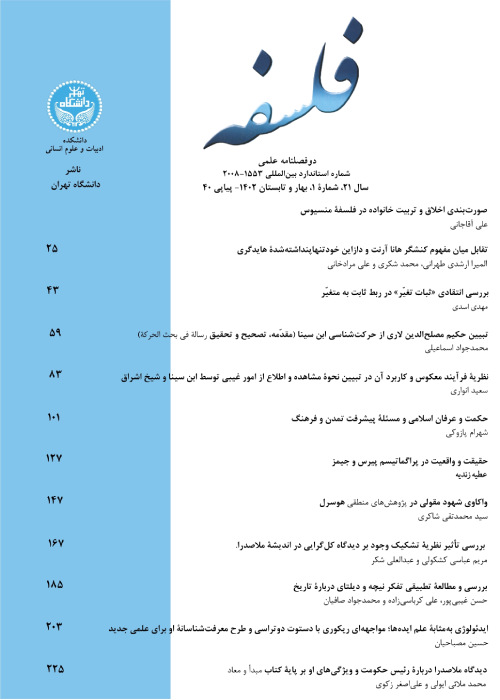فهرست مطالب
نشریه فلسفه
سال سی و هفتم شماره 3 (زمستان 1388)
- تاریخ انتشار: 1388/11/15
- تعداد عناوین: 5
-
Page 5What follows is an attempt to see Otto the phenomenologist within wider developments in the field, and to take account of some recent criticisms. Everything that is said falls under the general headingof ''introduction to the study of religion''(or ''meta-religionswissenschaft'') Within this wide field, we shall be specifically concerned with the possibility of a systematic phenomenology of religion, and with that phenomenology of religion which takes its starting point from Otto''s awareness of the numinous in its non-rational and rational forms and manifestations. In addition to this central insight of Otto''s and deriving to a large extent from it, are the morphological categories which can be traced back further than Otto to Chantepie de la Saussaye (1869-1937). These categories form part of classical phenomenology of religion down to Friedrich Heiler (1892-1967). We shall come back to these categories after looking at Otto''s numinous as the starting point for a global phenomenology.
-
Page 21The aim of my argument (1) is to reconceptualise what is now called religious studies as the study of institutionalised values, and the relation between values and the legitimation of power in a specific society. Though I do not talk much about power here, it is always a fundamental issue in the study of specific social groups.The first assumption which I make in this paper is that the way analytical concepts are or are not used is important. Nothing is ever perfect but fuzzy, ambiguous and contradictory concepts can create false problems and false understanding. We work with guiding notions the whole time: if they are left unclarified they are dangerous. If they are made explicit, we can see where we stand in relation to a particular writer. We can see how s/he is using a key word and we can agree or disagree.
-
Page 37The phenomenon of Western Sufi teachers is unique, not just because of the individuals themselves, though they are certainly fascinating, but because of what they represent: the flowering of the Western genius, which has discovered Eastern traditions, absorbed them and in the process changed them and been changed by them. This paper is a primary outline of the main contours of this phenomenon, trying to brief its history and attempt an explanation of what it means.
-
Page 65Though it is widely assumed that Sunni Islam does not have an equivalent to the Christian ecclesiastical hierarchy, Shii groups such as the Medieval Ismailis did have an organised teaching, spiritual, and temporal hierarchy. Evidence gathered from primary sources shows that this Ismaili ''ecclesiastical'' hierarchy is strictly intertwined with the Ismaili interpretation of Neoplatonic cosmology as well as with the political authority of prominent medieval Ismaili dynasties.It is widely accepted by scholars in Islamic studies that there is no ecclesiastical hierarchy in Islam or, in other words, that there is not one hierarchical body which can legislate in matters of religion and the authority of which is undisputed among Muslims. There are experts in religious matters, the ''ulama`, with their theological and legal specializations. However, these are only individuals, and no matter how highly esteemed they are, they do not represent a full body. Even when Muslim scholars have presented elaborations of Islamic creeds, it is understood that they are no more than individual formulations of belief, not official ones. This assumption perpetuates a myth: the myth of one, static, uniform and united Islam. This is the Islam that many Sunnis would like to believe exists, and the Islam that several Western scholars find more convenient to study. Recent introductory books on Islam have just started to include chapters which reflect a more accurate story: there is not one Islam, there are several Islams, or to put it more moderately, there are several interpretations of Islam. There is the mystical way, with its hierarchy of spiritual masters and angels, there is popular Islam with its hierarchy of saints, and there is Shii Islam. Even though Shiism represents only 10% of the total Muslim population, it is nevertheless very active, articulated and in itself composite. This paper examines the authority of the "ecclesiastical" hierarchy, that is the teaching, spiritual and temporal hierarchy, in Medieval Ismailism. My aim is to establish a relationship between this hierarchy and the cosmological doctrines of Medieval Ismailism. Even though Ismailism is not the only Shi''i group in Islam to exibit both an ecclesiastical hierarchy and a related cosmological structure (medieval Druze and Nusayri groups are two further examples), it has been chosen here because of the high degree of sophistication and the clarity in which these doctrines have been expressed.
-
Page 77The philosophy of biology has existed as a distinct sub-discipline within the philosophy of science for about thirty years. The rapid growth of the field has mirrored that of the biological sciences in the same period. Today the discipline is well represented in the leading journals in philosophy of science, as well as in several specialist journals. There have been two generations of textbooks and the subject is regularly taught at undergraduate as well as graduate level. The current high profile of the biological sciences and the obvious philosophical issues that arise in fields as diverse as molecular genetics and conservation biology suggest that the philosophy of biology will remain an exciting field of enquiry for the foreseeable future.


